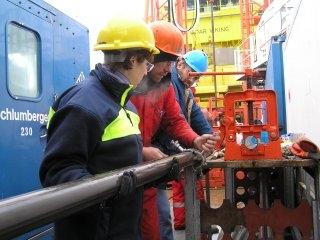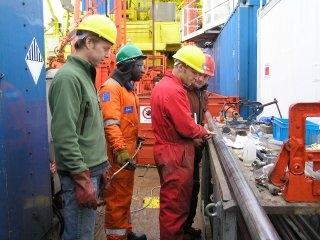22 August, 2004
Aboard the Vidar Viking
Today I awoke with a new sense of excitement as it was my day to spend some
time aboard the drill ship, the Vidar Viking. The drilling is proceeding
extremely well and they are starting to rotate the non-"scientists" over to
the Vidar to assist and observe the drilling process first-hand. There is a
limit to the number of people allowed aboard due to safety concerns so we
are taking turns going over to take part in a 12 hour shift. My shift was
from 1100 - 2300 (11 am to 11 pm). I was dressed in my warmest clothes,
including my fleece and outer SPRS jackets, wind pants, gloves, and hard hat
borrowed from the British Geological Surveys folks. On my feet I wore my new
steel-toed boots; these were purchased specifically so I could go onto the
Vidar if the opportunity arose. I was told there would probably be extra
boots available on the drill ship, but I wasn't taking any chances that
boots wouldn't fit and I would have to stay behind.
I want to capture as much of the activity as possible so in addition to my
notebook I bring my video camera, Erik's video camera, my digital camera and
my 35mm film camera. I think I'll have enough cameras for the day!!
As soon as we arrive by helicopter we must go up to the bridge so that we
can sign into the log book as guests on board. Jan Backman, expedition
co-chief, signs in the regular shift members, but hands me the pen to sign
myself in. After a quick look-see as to the layout of the ship, it is down
to the drill deck.
Once we walk onto the deck we see that a core has just been brought up. This
one is amazing, with dramatic color changes and everyone crowds around to
see. On the Oden all I had seen of the cores was a very small sample taken
from the end of a core, but here is a 4.5 meter long core straight from
below the Arctic Ocean floor. Truly, sometimes I am amazed that I am here
parcticipating in such important scientific research and discovery. I hope
that I can convey some of this excitement to my students when I return to
school. To think that what is happening here will change what is known about
the Earth's history! Mind-boggling, really!
There is a strict protocol and procedure for dealing with the cores, so I
step aside to watch as the core is measured into 1.5 meter segments, sealed,
labeled and put aside. Some geological tests will be run on the Vidar, then
the cores will be refrigerated and stored to be transported to the
University of Bremen, Germany.
After watching a bit of that process, I wandered back out onto the deck to
see what was happening next. There is not a moment wasted here; one filled
plastic core liner comes up out of the drill pipe and another empty liner is
put in the drill pipe and that is lowered down into the hole, now about 200
mbsf (meters below the sea floor). The drillers are very helpful in
explaining the process once the pipe is on its way down and they have a half
hour or so until it starts back up. I get a tour of the deck, see where the
pipes are stored until they are needed, where the lubricating "mud" mixture
is made, and where the drill operator works. The "mud" is not really mud,
but a mixture made from a cellulose material and water, with a consistency
and viscosity very similar to wall-paper paste. This "mud" is pumped down
into the space inside of the drill pipe; it lubricates and cools the drill
bit as well as forces drill cuttings up the drill hole and deposits them on
the sea floor.
I watch the drillers direct the drill string down the pipe and monitor it
from the "rooster box", a platform high up on the drill rig. I have no
burning desire to be up atop the rig, especially as I watch the drillers
scramble up and down the vertical ladder rungs that take them high above the
drill floor.
Instead I climb up a much shorter ladder to visit Danny in the drill control
box. He graciously gives me a lesson in drill operation and the importance
of monitoring and controlling the pressure of the drill pipe. He allows me
to stay and watch as he lowers the pipe down to the new depth and starts
drilling. As I watch he controls a drill string supporting 50-60 tons of
drill weight!
What is even more amazing to me is the way they add a new drill pipe length
to the existing one to go deeper into the sediment. There is a mechanism
called the "iron roughneck" that clasps and the top of the existing drill
pipe and supports all that is still suspended about 1200 meters below the
ship! The top pipe is then disconnected and with a series of clamps and
lifts, a new pipe length is attached, carefully screwed into place with the
correct amount of torque applied, and the drilling continues. As I watch,
the whole process proceeds seamlessly.
It is cold standing out on the drill deck so it is welcome relief to go back
inside the heated "science labs", the metal containers sitting on the deck.
I watch as Matt O'Regan, a Graduate Student in Marine Geology from URI,
sends the cores through the MSCL. This is a machine that performs several
physical property tests on the core, for instance measuring density, sound
velocity and magnetic susceptibility. Because this information is collected
every 2cm along the entire length of the core, it gives a high resolution
picture of the physical property changes in the sediments that in turn can
show climactic changes.
In the next container over, a Professor in Geochemistry from Rice
University, Jerry Dickens, collects samples of sediments and pore water
(water collected from microscopic spaces between the sediment grains). Later
a series of chemical analyses will be run on these samples. The results from
these tests will show not only chemical reactions that occurred in the
sediments in the past, but also how those reactions translate to what is
happening in the waters and sediments today.
The scientific information gathered on the expedition while it is at sea,
will be added to by onshore analyses of collected samples. While the
micropaleontologists back on the Oden will sample the small amounts of
sediments we bring back at the end of our shift, they and other scientists
will examine the full collection of cores when they meet in November in
Bremen, Germany. What I am taking part in is a small part of extensive
scientific analysis.
The helicopter returns at 11 pm bringing the next shift of scientists, led
by the other expedition, co-chief, Kate Moran. Wearily I board the
helicopter back to the Oden to share my experiences and then head to my
cabin.

Helping measure and cut the core.

Matt O'Regan and some of the Vidar Viking drillers.
Contact the TEA in the field at
.
If you cannot connect through your browser, copy the
TEA's e-mail address in the "To:" line of
your favorite e-mail package.
|
